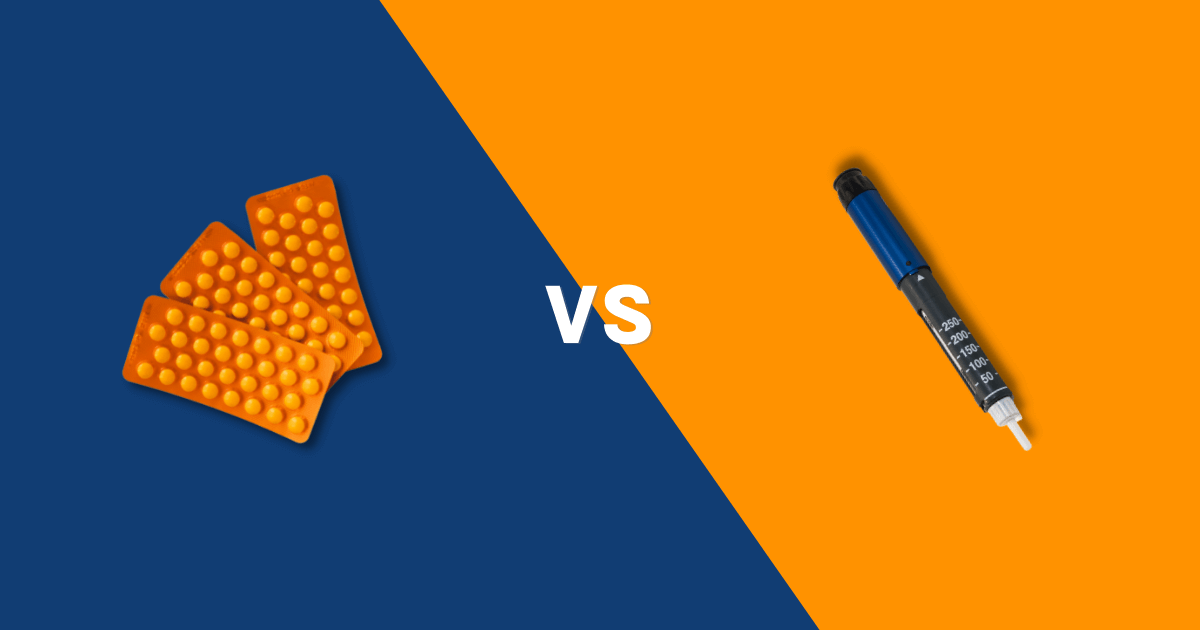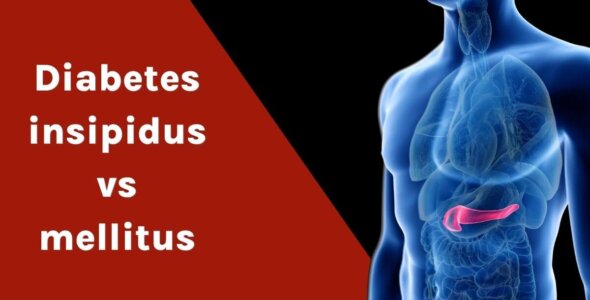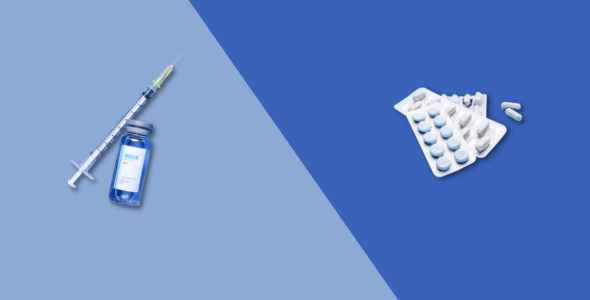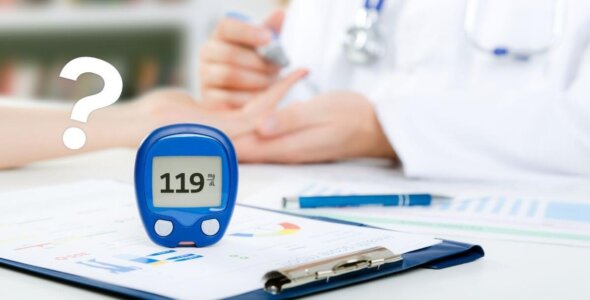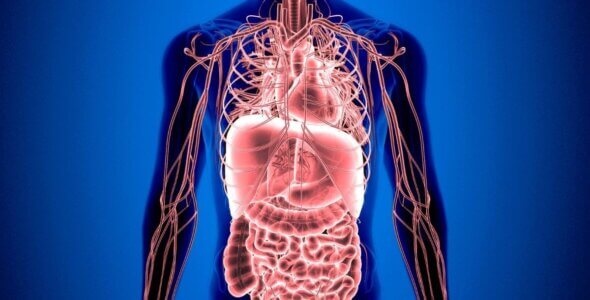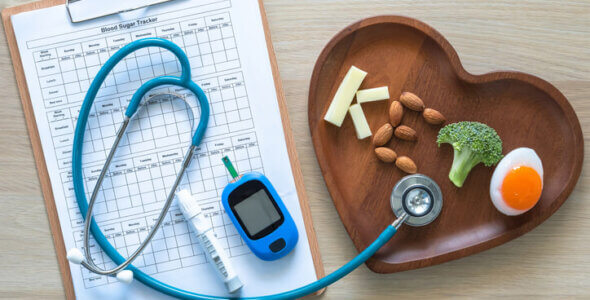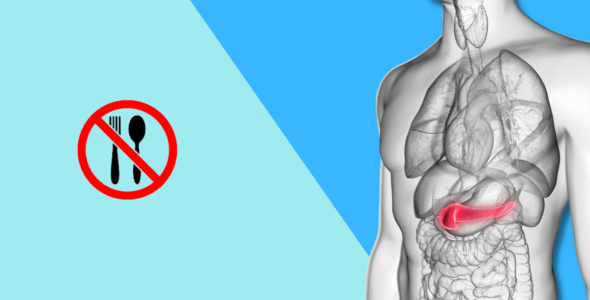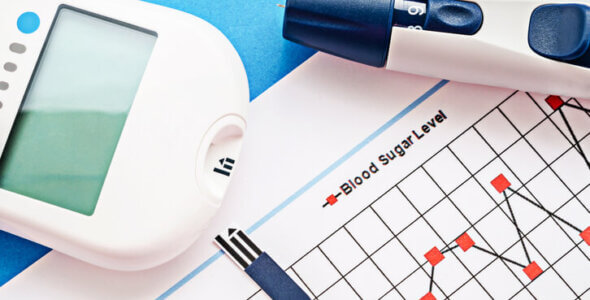Type 1 vs type 2 diabetes
Table of contents
- How many people have diabetes?
- What are the causes of type 1 and type 2 diabetes?
- What are the risk factors for type 1 and type 2 diabetes?
- What does diabetes do to the body?
- Type 1 vs type 2 diabetes symptoms
- How are type 1 and type 2 diabetes diagnosed?
- Type 1 vs type 2 diabetes treatment
- How to prevent type 1 and type 2 diabetes?
- What is the outlook for people with type 1 and type 2 diabetes?
- Type 1 vs type 2 diabetes FAQs
What is the difference between type 1 and type 2 diabetes? You may already know that more than one form of diabetes exists, but Type 1 and type 2 diabetes are two separate conditions with some similarities. Each has its own symptoms, causes, and treatments. Diabetes arises when a person cannot make enough insulin or the insulin a person makes is ineffective at controlling blood sugar levels. The end goal for both types of diabetes is to keep blood sugar levels stable and reduce complications. Let us take a look into both of these forms of diabetes.
How many people have diabetes?
The Centers for Disease Control and Prevention reports that more than 34 million people have diabetes in the US, of which 90-95% have type 2 diabetes and the remaining 5-10% have type 1 diabetes. Men and women develop diabetes at around the same rate. However, significant differences are seen among different races and ethnicities.
What are the causes of type 1 and type 2 diabetes?
The most important hormone to understand in diabetes is insulin. It is made in your pancreas which is located just behind your stomach.
Without getting too medical, insulin travels in your blood through your body. It opens up cells in your body so that glucose can enter them. After glucose enters cells, the cells immediately use it for energy in the form of glycogen or convert it to fat for use later. When glucose leaves your blood and enters cells, your blood glucose level falls. Your pancreas detects your glucose falling and turns off the release of insulin. This stops your blood sugar from going too low (hypoglycemia). At the same time, your liver begins to make more glucose in your blood.
This whole system in the body keeps the correct level of glucose. Insulin is the only means that the body has of lowering blood glucose levels. When this system fails diabetes occurs. Each type of diabetes involves the pancreas not functioning properly.
Type 1 diabetes
In type 1 diabetes you do not produce insulin. This is because your body mistakes your own healthy cells as foreign invaders and attacks the cells that produce insulin in the pancreas. Once these cells are attacked they are unable to produce insulin. We do not currently know why the immune system in type 1 diabetes does this but research is ongoing. Type 1 diabetes starts most commonly in younger patients but can occur at any age.
Type 2 diabetes
In type 2 diabetes you do produce insulin, but the body can not use it effectively. There is usually a combination of a part failure of insulin production and a reduced response to the hormone. This is known as insulin resistance. Research does not give us a clear idea why some people develop this and others don’t, but lifestyle factors, e.g. lack of exercise and excess body weight can contribute to type 2 diabetes.
What are the risk factors for type 1 and type 2 diabetes?
Type 1 diabetes risk factors include:
- Parent or sibling with type 1 diabetes
- Most commonly seen in children and younger people
- Genetics affects the way the body produces or uses insulin
- Exposure to some infections or viruses
Type 2 diabetes risk factors include:
- Aged over 40 years
- Smoking
- Excessive belly fat
- Physically inactive
- Unhealthy diet
- Gestational diabetes during pregnancy
- Slightly raised blood glucose levels
- Pre-diabetes
- Immediate family member with type 2 diabetes
- Polycystic ovary syndrome
- Ethnicity group – Black, Hispanic, Native American Indian, Alaskan Natives, Pacific Islanders, and some people of Asian origin
What does diabetes do to the body?
Having diabetes means that glucose builds up in your bloodstream to a dangerous level. If this level is not reduced by medication and lifestyle changes eventually the body will be damaged. High glucose levels lead to complications such as kidney disease, foot problems, eye problems, and heart disease.
Type 1 vs type 2 diabetes symptoms
Type 1 diabetes symptoms:
- Frequent urination
- Increased thirst
- Increased hunger
- Blurred vision
- Fatigue
- More frequent infections
- Weight loss
- Dry skin
- Slow-healing sores
- Stomach pains, nausea, or vomiting
Type 2 diabetes symptoms:
- Frequent urination
- Increased thirst
- Increased hunger
- Blurred vision
- Fatigue
- More frequent infections
- Numbness in hands, feet, or legs
- Genital itching
- Obesity
The signs and symptoms of type 1 and type 2 diabetes are similar but there are some differences:
- Age of onset – Type 1 diabetics are usually younger than type 2 diabetics
- Weight – Type 1 diabetics are likely to be normal weight but obesity is common in type 2 diabetics
- Onset – Type 1 diabetics have a sudden onset of diabetes but type 2 diabetics have slow progressing symptoms
How are type 1 and type 2 diabetes diagnosed?
Tests to diagnose both type 1 and type 2 diabetes
- Fasting blood sugar test – After an overnight fast your blood glucose level will be measured
- Glucose tolerance test – After an overnight fast your blood glucose level will be measured, followed by a drink containing glucose. Your blood sugar will then be retested every half hour for two hours to see how your body is responding
- Random blood sugar test – This test does not require an overnight fast but is taken any time of the day
- Hemoglobin A1c test – As a diabetic, you definitely need to know about this. Hemoglobin A1c measures the average blood sugar control over the last two to three months. When glucose attaches to hemoglobin in the bloodstream it is called Hemoglobin A1c. The more glucose in the blood, the more hemoglobin A1c forms. This form of hemoglobin remains in the blood for 2-3 months therefore it gives a good reflection on what is going on in the body rather than a single snapshot result. A1C test results are reported as a percentage. The American Diabetic Association diagnose diabetes as an A1C of greater than or equal to 6.5%
Type 1 vs Type 2 diabetes diagnosis chart
| Result | A1c |
|---|---|
| Normal | Less than 5.7% |
| Pre-diabetes | 5.7%-6.4% |
| Diabetes | 6.5% or higher |
Test to diagnose type 1 diabetes only
- Autoantibodies test – A blood test without fasting to look for autoantibodies linked with type 1 diabetes
- Ketones test – A urine test to measure ketones
Type 1 vs type 2 diabetes treatment
Type 1 diabetes treatment
The only treatment for type 1 diabetes is insulin. If you have this type of diabetes your body is unable to produce insulin therefore you need to inject it directly into the body. As a result, there is no cure for type 1 diabetes. Insulin finely controls the amount of glucose in your blood. It allows glucose to enter cells so they can use it for energy and function. Insulin also plays an important role in growth in three main ways. Firstly by supporting fat and muscle to form. Secondly by allowing the storage of glucose in a form called glycogen for use when fuel isn’t coming in. Finally it blocks the breakdown of protein.
If you have type 1 diabetes you will inject insulin directly into soft tissue such as the stomach, upper arm, or buttocks several times a day. You have different ways to inject insulin, such as using a syringe, insulin pen, insulin pump, and jet injections. These are some of the most common brands of insulin available in the US:
Type 2 diabetes treatment
The first recommended treatment for type 2 diabetes is typically lifestyle changes, such as losing excess weight, getting regular exercise, and eating a healthier diet. If lifestyle changes do not work, then you may be prescribed medications to help lower your blood glucose. Most medications for type 2 diabetics are oral drugs. However, a few come as injections. Some people with type 2 diabetes may also need to use insulin. A wide variety of diabetes medications are available, these are some of the most common:
SGLT2 (Sodium-glucose transport protein 2) inhibitors examples include:
DPP-4 (Dipeptidyl peptidase 4) inhibitors examples include:
Alpha-glucosidase inhibitors examples include:
- Precose
- Glyset
Glucagon-like peptides examples include:
Biguanides -the most common biguanide is metformin, examples include:
Meglitinides examples include:
- Starlix
- Prandin
Sulfonylureas examples include:
Can diet help type 1 and type 2 diabetes?
At its core, diabetes is all about how your body deals with the food and drink you consume. Changing your diet can help to reduce how much glucose is released into your blood at a time, and it can help improve insulin resistance.
Diet and type 1 diabetes
If you follow your treatment plan and take your insulin, you can eat a normal diet and there are no foods you need to avoid. Eating a healthy diet and keeping your weight down can lessen the risk of diabetes complications such as heart disease and stroke.
Diet and type 2 diabetes
Changing your diet can be an effective way to control and manage type 2 diabetes. Eating a poor diet can increase your weight, blood pressure, and cholesterol. A diet high in fat, sugar, and refined carbohydrates may also contribute to insulin resistance. Making the right food choices can have a significant effect on your condition.
How to prevent type 1 and type 2 diabetes?
Unfortunately, type 1 diabetes can not be prevented. You may lower your risk of developing type 2 diabetes by lifestyle changes and developing new routines, such as:
- Keeping to a healthy weight
- Increase your activity levels
- Eating a healthy diet
- Reduce smoking
What is the outlook for people with type 1 and type 2 diabetes?
Diabetes is a chronic disease but on the whole, the prospects for someone with diabetes are better than ever before. A better understanding of diabetes and improvements in treatments can give you confidence that you really can be in control of your diabetes. It is equally important to take responsibility for your health by:
- Paying close attention to your diet
- Carrying out regular tests on your blood and urine to track your progress
- Making time for exercise
- Educating yourself about diabetes
- Taking your medications routinely
- Keeping a positive attitude
Type 1 vs type 2 diabetes FAQs
Which is worse, type 1 or type 2 diabetes?
It is sometimes thought that type 1 diabetes is worse as it starts suddenly and you need to inject insulin. On the other hand, type 2 diabetes starts much less dramatically and can initially be treated with lifestyle changes. Given that both types of diabetes have their challenges and complications one type can not be classed worse than the other.
Is type 1 or type 2 diabetes curable?
Type 1 and type 2 diabetes are lifelong conditions that can be significantly improved but not cured. You can reverse diabetes symptoms for some time, but there is always the chance they could return. Meal planning, healthy eating, exercising, and maintaining a healthy weight are essential habits to keep diabetes symptoms away. “Reverse” does not mean a forever cure. Diabetes is an ongoing disease.
Can type 2 diabetes turn to type 1?
No. Type 2 diabetes can not turn into type 1 diabetes since the two conditions have different causes.
How long can type 1 diabetes go untreated?
Type 1 diabetes can go untreated until you notice bothersome symptoms that lead to a blood sugar test by your doctor confirming a diagnosis. Untreated type 1 diabetes can cause heart disease, stroke, as well as eye and kidney diseases.
Can you get type 1 diabetes later in life?
Yes. Type 1 diabetes typically occurs in children and teens but can occur in adult life too. As an adult, it is not as straightforward to diagnose type 1 diabetes as the symptoms take longer to appear.
Medically reviewed
A medical professional has reviewed this article.


Jamie Winn, PharmD
Jamie Winn, PharmD
Dr. Jamie Winn received his Doctor of Pharmacy in 2002 from the University of South Carolina College of Pharmacy, Columbia, SC. Jamie is a medical reviewer for NiceRx.

